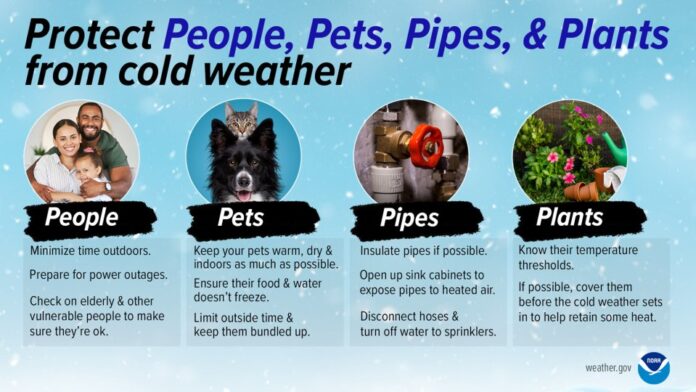HUNTSVILLE, Ala. – Are you prepared for the cold? As temperatures drop, remember to protect the four P’s: people, pets, pipes and plants. (weather.gov/safety/cold)
Extremely cold air comes every winter into at least part of the country and affects millions of people across the United States. The arctic air can be dangerous. Combined with brisk winds, dangerously cold wind chill values can result.
People exposed to extreme cold are susceptible to frostbite and can succumb to hypothermia in a matter of minutes. Areas most prone to frostbite are uncovered skin and the extremities, such as hands and feet. Hypothermia occurs when the body loses heat faster than it can produce it.
Cold weather can also affect crops. In late spring or early fall, cold air outbreaks can damage or kill produce for farmers, as well as residential plants and flowers.
A freeze occurs when the temperature drops below 32°F. Freezes and their effects are significant during the growing season. Frost develops on clear, calm nights and can occur when the air temperature is in the mid-30s. Each plant species has a different tolerance to cold temperatures.
The way to avoid frostbite and hypothermia is to plan for extreme cold before it arrives. Don’t get caught unprepared.
- Check the forecast at weather.gov or your favorite weather app, station, etc.: Make checking the forecast part of your regular routine so you’ll know when to expect cold weather.
- Adjust your schedule: If possible, avoid being outside during the coldest part of the day, typically the early morning. Try to find a warm spot for your children while waiting for the school bus outside.
- Protect your pets, livestock and other property: If you have pets or farm animals, make sure they are not overly exposed to extreme cold and have plenty of food and water that has not frozen. Take precautions to ensure your water pipes do not freeze. Know the temperature thresholds of your plants and crops.
- Fill up the tank: Make sure your car or vehicle has at least a half a tank of gas during extreme cold so that you can stay warm if you become stranded.
- Dress for the outdoors even if you don’t think you’ll be out much.
- Update your winter car survival kit: Make sure your car survival kit has the following:
- Jumper cables: flares or reflective triangle are great extras
- Flashlights: Replace the batteries before the winter season starts and pack extras
- First aid kit: Carry essential medications with you in a purse or bag
- Baby gear: Diapers and any special formula or food
- Medical supplies: Materials for any special medical needs.
- Food: Nonperishable food such as canned food and a can opener, dry cereal and protein rich foods like nuts and energy bars
- Water: At least 1 gallon of water per person a day for at least 3 days
- Basic toolkit: Pliers, wrench, screwdriver
- Pet supplies: Food and water
- Radio: Battery or hand cranked
- Cat litter or sand: For better tire traction
- Shovel: To dig out snow
- Ice scraper: Have one in the car even if you usually park in a garage
- Clothes: Dress for the weather in warm clothes, gloves, hat, sturdy boots, jacket and an extra change cold weather of clothes
- Warmers: For body, hands and feet
- Blankets or sleeping bags: If you get stranded you’ll be glad to have it.
- Charged cell phone: And keep a spare charger in your car






















